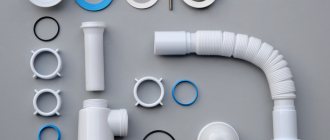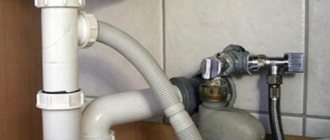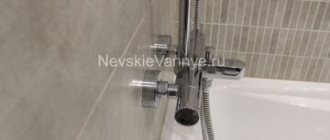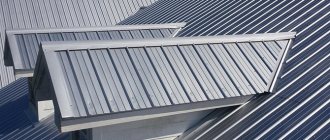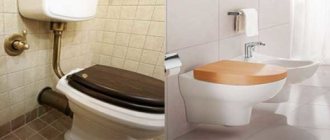A sink siphon with overflow is an improved version of one of the key elements of the sewer system. Just like a regular siphon, it is a structure of hermetically connected curved pipes, often supplemented by a settling tank. But it has one useful element - an overflow, which has the form of a pipe connected to an additional hole in the sink, through which water, which for some reason did not go through the main drain, will fall into the sewer system, and will not flow over the edge onto the floor.
Conventional flush-overflow system
A small hole in the top of the sink.
Water drains through it if you forget to turn off the tap or the pressure is too high. This system was invented in Western Europe and is especially common in England, where they use water very sparingly and wash from a bowl with a closed drain, which increases the risk of flooding. When the water level rises above the maximum level, the water flows through the overflow hole into the drain rather than onto the floor. In our country, it is customary to wash under a stream; the need for a “drain-overflow” arises less often, but most sinks are still equipped with a “drain-overflow” system. This is not an additional option, but an integral part of the design of the sink: either it is there or it is not.
Does such a system prevent flooding?
Under certain conditions. If the drain-overflow system is even slightly clogged or a foreign object has entered the drain channel, flooding is inevitable, as is the case if the bottom valve is closed. But the overflow will happen later.
Installation of the foot valve
Installation of mixer and bottom valve
You can install any valve yourself. Installation of a mechanical valve is as simple as possible. The valve itself is inserted into the drain hole and fixed. A spoke is connected to the lever and the valve ear; it is responsible for opening and closing the plug.
After installation, the siphon is connected. The functionality of the valve and the presence of leaks are checked. If the device operates and there are no leaks, the valve is ready for use.
If there is an overflow hole, be sure to connect the hose to the siphon.
Automatic bottom valve (installation)
There are faucets with an automatic valve, equipped with and without an overflow. Let's consider their installation. Before installation, it is worth checking the length of the pipes (they can be rigid and must be shortened)
When reducing the length of the pipes, be sure to rinse the unit under running water in all directions for 3-5 minutes. This will help to avoid operational disruptions. It is better to place the mixer on a sealant, which will increase the quality of fit and service life.
The valve is installed in the sink hole. The lever mechanism itself is immersed along with the mixer. After fixing, we connect all the tubes and hoses under the sink.
A water seal (bottle or tubular siphon) is placed in the drain, and the valve spokes are folded into the shape of an equilateral cross. They are fastened with a self-tapping screw in a cross-shaped form made of plastic. The ends of the spokes are connected according to the scheme: with a lever on one side and with a valve loop on the other.
Vertical forward movements will provide a future mechanism for draining water when the lever is pressed. If there is an overflow system, don’t forget to connect it. We connect the lever of the mechanism to the valve and attach the siphon. We check for leaks.
Tubes and hoses can be bent but remain in a U-shape. The zigzag shape of pipes is contraindicated. If there is a leak, it is recommended to disassemble the structure and first tighten it.
In case of no result. We advise you to go through the system and install it again. In rare cases, a manufacturing defect may occur. Faucets equipped with a valve without overflow are installed in the same way.
Installing an automatic valve to an existing faucet
There are bottom valves for faucets (such faucets have a hole for the lever). If there is none. The installation task is more difficult, but doable. To do this you will need a hole for a lever or button. If the sink is metal, you can make a hole yourself. And install the valve according to the instructions.
In the case of a ceramic washbasin, there is an option. But it is worth purchasing a bottom valve with a side button. It can be mounted in the overflow hole.
A mechanical valve is suitable for a washbasin.
The automatic valve is ideal for the kitchen. Immersing your hands in dirty, greasy water is unpleasant. Pay attention to the tools; it’s good if they don’t have sharp corners. Line the sink with cardboard or other material before installation to avoid damage.
Gaskets occupy a special place during installation; do not forget about them. Tighten all nuts and bolts tightly.
Source
Hidden drain-overflow system
A modern alternative to the conventional system.
Its presence is outwardly invisible and practically eliminates flooding. Due to the absence of an extra hole in the sink, it looks more aesthetically pleasing and the surface is less dirty. The hidden “drain-overflow” system is quite complicated to implement and the combination with it increases the cost of the sink, but it is a very convenient and aesthetic option.
Device.
Some manufacturers use CLOU technology: a hidden siphon is used for overflow, located behind the back wall of the bowl and connected by two channels to the drain pipe. If the drain is blocked by a built-in bottom valve (of a special design), the water in the overflow device will rise along with the general water level and when it reaches the maximum specified height, the excess volume will overflow through the siphon partition and go into the drain pipe below the bottom valve. There is another technology: as soon as the water reaches a certain level, the system will automatically recognize this and open the drain plug itself.
On the picture:
Bowls without drain-overflow system
If you are purchasing a standard sink without accessories, a siphon will not be so difficult to purchase. If you choose a designer model, it is advisable to purchase a siphon included.
In the photo: siphon A750114CR from Daniel Rubinetterie.
Bowls on the tabletop.
The design of the bowl may be hampered by an extra hole, or due to its unique shape there is nowhere to mount a drain channel, and not all sinks can be equipped with a built-in system. Most often, there is no “drain-overflow” in bowls that are placed on the countertop, visible from all sides, or, for example, in sinks made of colored glass or natural stone.
Alternative.
Such bowls will necessarily (this is the norm for manufacturers) be equipped with a regular drain, which cannot be blocked - although it has a “cap”, its function is only decorative. When choosing fittings for such a drain, take into account the minimum and maximum thickness of the entire structure (sink, countertops in the place where the drain is installed).
On the picture:
Invisible drain
No holes.
The water spreads over the flat bottom of the sink and disappears at the edges. Where does she go? Into small grooves around the perimeter of the bowl, which can be detected by looking closely, and then into the drain. Most often, rectangular sinks with a straight or sloping bottom, made of ceramics, artificial and natural stone, wood, and glass, are equipped in this way. Regardless of the shape of the bowl, such an unusual drain in the bathroom is mounted to the sewer system in the usual way. There are no problems with water overflow, since the throughput of such a drain is no less, and often greater, than that of conventional bowls, since it has a large drainage area.
Source
Siphon for a sink with overflow: features and nuances of choice
Such a plumbing detail as a siphon is known to almost everyone. It firmly takes its place in every home and apartment, and there is simply nothing to replace it. A siphon is a hydraulic valve. In plumbing terms, this product is a water valve that prevents sewer gases from escaping into the room through a hole in the sink or through the toilet. In the modern world, all products that perform drainage are considered to be a siphon, but this is not entirely true. The sink siphon with overflow is especially famous.
Siphon: types, how to assemble, which one to choose
Siphon is the main element of a plumbing connection, designed to drain water into the sewer riser. In addition, the siphon provides protection against blockages and also acts as a barrier that prevents sewer odors from entering the room. In this article we will tell you about all types of siphons, how to select, assemble and replace them.
What is “overflow” and why is it needed?
Sink siphon with overflow
An overflow is a pipe through which water comes out of a sink when it has reached a certain level. Simply put, an overflow prevents water from overflowing over the edges of the sink. If for some reason the water does not come out through the sink mesh, then, having reached a certain level, it simply flows out through an additional hole - the overflow.
This truly useful invention appeared relatively recently. In Europe, cases of flooding due to water overflowing from the kitchen or bathroom sink have become more frequent. For this reason, nosy Europeans invented an additional hole in the top of the sink, which eliminated the risk of overflow. The kitchen sink siphon with overflow instantly gained popularity. Initially, it was made from the most accessible and relatively inexpensive material - cast iron.
Connection materials and standards
In the production of the vast majority of models of overflow devices, polymeric materials are used: polyethylene or propylene. Brass, copper and stainless steel are less common, as they occupy the segment of high-quality expensive products. The chrome-plated sink siphon is distinguished by its special aesthetic sophistication, which will look impressive on plumbing fixtures installed in an open manner, without installing it in furniture or decorative structures.
Despite the huge variety of forms of outlet fittings, all of them are typical water seals, with the exception of the siphon of a dry design.
Thanks to the inert materials of modern water seals, they are not subject to corrosion, unlike their previous cast-iron counterparts, and the low roughness of their internal surfaces makes it difficult for fatty deposits to form. For the same reason, models in which the outlet and overflow channels are assembled from rigid pipes are preferable. Sometimes they are more difficult to assemble and connect to the sewer, however, they will have to be cleaned less often than flexible corrugated connectors. In addition, the strength and service life of corrugations, especially polymer ones, leaves much to be desired.
Overflow siphon-spark with outlet for washing machine
When choosing a siphon for a kitchen sink, it is important to determine the diameter of its outlet and overflow pipes. If Ø 25 mm is sufficient for an overflow, then the main outlet should be much thicker. Today, the most common standards are Ø32 mm and Ø 40 mm. For households where you have to cook a lot, and even more so when there is an abundance of fatty food, preference should be given to products with outlets Ø 40 mm, they are less susceptible to blockages. Convenient for connection is the drain fitting, which has an outlet of Ø32 mm or Ø 40 mm, adapted by a transition to Ø 50 mm for direct connection to a sewer of the same standard diameter.
On a note. All types of drain fittings with an overflow pipe can have additional outlets with Ø 19 mm herringbone fittings for connecting washing and dishwashing equipment, and can also be equipped with a bifurcated inlet designed for installation on a double sink.
Siphon straight, corrugated or with an elbow?
In addition to the well-known elbow, not long ago a similar product appeared without a sump. It is a corrugated or straight pipe. The corrugated one can be tilted at any angle and even reduced in size. Their functionality knows no bounds, but there is still one drawback.
A straight corrugated siphon, due to a non-smooth inner surface, can accumulate impurities in its relief. This threatens extensive blockage and an unpleasant odor.
A siphon for a sink with a bottle-type overflow is an optimal and, not least important, inexpensive solution. In plumbing stores you can see a lot of hydraulic valves, which differ mainly in the presence of an overflow. All modern siphons are made exclusively of plastic.
Quite recently, it would seem, all apartments had cast iron water valves, and no one even knew about corrugated polypropylene pipes. Of course, cast iron products had plenty of advantages, but there were more disadvantages. Cast iron is heavy and bulky. Such a siphon does not have an aesthetic appearance and is prone to corrosion and destruction.
A siphon for a kitchen sink, according to experts, must have an overflow.
Types of siphons with overflow
Models and prices
The names, appearance, country of origin and prices of some valve models are presented in the table below.
| Name | Manufacturer country | Price, rub |
| Kludi 1042705-00 | Germany | 500 |
| Vitra A45137EXP | Türkiye | 595 |
| Elghansa siphon WBT12 | Germany | 1000 |
| Viega 103385 | Germany | 780 |
| Elghansa siphon WBT12-bronze | Germany | 1360 |
| Kludi 1042405-00 | Germany | 1800 |
Sinks and siphons
The use of overflow in siphons began several centuries ago, and it is obvious that this development has taken root. Now all manufacturers create sinks with an overflow hole, as demand creates supply. By the way, there are a great variety of materials for making sinks.
In the modern plumbing market, you may encounter difficulties in choosing a sink; there is a huge variety of them. As for the siphon, its choice cannot be called difficult. You need to choose only one type out of three and not “miss” the choice of manufacturer.
In Russia, several manufacturers are engaged in the production of hydraulic valves and other plumbing elements. It is worth saying that domestic plumbing is not inferior to European, but is more affordable in terms of price.
Siphons are mostly created from plastic, but it is also possible to create a unique product from copper and tin. They are produced in single quantities, since the demand for them is not high. They do not differ in functionality from their plastic counterparts, but, of course, they look much more solid.
A copper siphon is a striking product, but you should be wary of streaks and darkening caused by time and moisture. This product must be properly cared for.
Recommendations for choosing a siphon
In order to make the right choice, you need to listen to the following recommendations:
- You should not buy a siphon and its accessories separately, because they may not be suitable for some parameters. Experienced craftsmen advise purchasing a whole set .
- You need to think in advance which model will best fit into the design of your sink . For example, if there is minimal space left under the sink, then it is advisable to buy a miniature siphon.
- Even simple models can be modified thanks to special devices. To do this, purchase plugs, various gaskets, plugs, which will be useful when installing a branched system.
- be handled with care during installation , as there is a risk of damaging (bending) them. This will cause debris to begin to accumulate in the pipe.
- If the installation involves a closed arrangement of the siphon, then you should not spend extra money on designer products, so the main thing here is to take into account quality .
Only when the bottom of the sink is open does it make sense to choose decorative designs
- As a rule, the siphon kit comes with instructions for its assembly , which must be studied before installation.
It is recommended to choose durable products from reliable manufacturers
Manufacturers
There are about a hundred manufacturers of plumbing fixtures in the world. Only a small part of them is located on Russian territory. Plumbing manufacturers try to keep up with the times, therefore they tirelessly introduce innovations. This applies to both large plumbing fixtures and related consumables.
A siphon for a sink with an overflow is, for the most part, made from high-quality plastic, but this is not always the case. There is plumbing that has been extremely popular for several decades. First of all, this applies to Italian manufacturers. It was in this country that the production of advanced, sophisticated and extremely functional sanitary ware initially started. She was distinguished by both beauty and unsurpassed quality. At the moment, Italy is the supplier of the highest quality and most sophisticated plumbing products.
Components of a siphon with overflow
When choosing a hydraulic valve, you should pay attention to a number of points. First of all, you need to focus on where exactly you plan to install the product. If in the kitchen, then the bottle type is the best option. If we are talking about a bathroom sink, then it is better to opt for a straight plastic pipe. Overflow in both cases is necessary, since it significantly increases the level of safety in the matter of possible floods.
Russian manufacturers, every single one, produce siphons with overflow. Cast iron products, which were used in all Soviet apartments in the recent 80s, are now practically not produced. They have high functionality, but are not reliable and durable. In addition, installing a cast iron product is not an easy task. While even a woman can install a modern siphon, not every representative of the stronger sex can install a cast iron siphon. The main “scourge” of such valves is the low level of tightness. It was necessary to make great efforts to join all the seams with maximum tightness. Often a kind of plasticine was used to prevent leakage.
Thus, the choice of siphon with overflow is limited to three varieties. Each has its own advantages and disadvantages that you need to pay attention to. Each product comes with installation instructions, which you should also read. The service life may be specified in the warranty card, but not every manufacturer provides it. On average, a plastic valve can last a couple of years if the sink is used daily. In the case of a toilet siphon, this period can be 6-8 years, since a different type of plastic is used for the manufacture of such structures, and the pipe walls are much thicker.
A hydraulic valve for a sink with an overflow is an excellent and modern solution that will eliminate annoying flooding and, as a result, material waste. The cost of such a product starts at 190 rubles. Depending on the type of device and manufacturer, the price of the part also changes.
Source
Common types
Manufacturers produce several types of sink siphons. They are selected depending on the characteristics of the installation site.
Some types of siphons: bottle with a tube, bottle with partitions, tubular
Corrugated drain
The corrugated tube is convenient to use when the sink drain hole has a non-standard location. This device is also used if you plan to install additional equipment or some necessary items under the sink
When connecting it to the sink, you need to pay attention to the amount of water in the curved place. It should be enough to create a reliable water lock, which guarantees reliable protection against the penetration of odors from the sewer
A drain in the form of a corrugated tube is not an ideal design, because dirt quickly accumulates on the ribs of the product.
Structurally, the corrugated siphon consists of the following elements:
- pipe with grille and union nut;
- corrugated tube
Additionally, pipe fastening may be required.
Drain with corrugated pipe
The corrugated drain is installed in a matter of minutes. First, we attach the outlet pipe with the grate to the sink. Fixation is carried out using the gasket and screw included in the kit. Then the corrugation is inserted into the pipe at one end and secured with a nut, and the other side is inserted into the sewer pipe. If cleaning is necessary, the corrugated hose is disconnected from the pipe and the sewer. Then it is washed or replaced with a new one.
Bottle drain
Bottle siphons are most often installed. They are well suited when you need to drain dirty water and other waste from multiple sinks. In this case, the required number of special bends is installed.
The design of the bottle drain consists of the following elements:
- metal or plastic grille;
- intake pipe;
- bottle container;
- pipe for draining sewage into the sewer;
- a transition piece that allows you to connect the siphon to the sewer system.
Bottle drain is a completely rigid product
If necessary, the design is supplemented with corrugation for more convenient connection to the sewer. Cleaning the bottle drain is done by unscrewing the bottom part of the bottle-shaped container and removing accumulated dirt.
Pipe drain
This type of siphon is installed not only on sinks, but also on bathrooms. It has a completely rigid structure - outwardly similar to the letters S and U.
Since many modern kitchens have dishwashers, the pipe siphon may have an additional outlet.
Straight pipe (direct flow) siphon
Pipe siphon for sink McAlpine (UK) with outlet for household appliances, 40 mm (MRSK6). The MRSK4A model is equipped with an angular outlet. When choosing, be guided by the specified sizes
There are models of tubular siphons with a break in the stream flow. Such siphons are not attached to the sink - after installation there is a difference between the siphon and the sink. It is necessary to prevent germs from the sewer from entering the sink. They are used in preschool institutions and catering establishments.
Flat drain
This is a small siphon under the sink, where size is critical. It is usually used when a “washing machine” or dishwasher is installed under the sink. There are models with a break in the jet flow.
The design is a regular knee, but it saves space
In addition to small dimensions, a distinctive feature of a flat drain is also its rigid design. Such siphons rarely become clogged. If there is a need to perform a complete cleaning, the grille is unscrewed, and then the entire structure is removed from the sink.
With overflow
When the sink has overflow protection, a siphon with overflow is installed under it. The design of the product includes an additional pipe, to which a small diameter tube is connected from the overflow hole in the upper part of the sink. This design prevents the sink from overflowing with water and reduces the risk of flooding the room and neighbors living on the floor below.
A siphon with overflow is installed not only for sinks, but also for sinks
There are also drains with one or two outlets at the neck. They are used when it is necessary to additionally connect a dishwasher or washing machine.
The overflow tube connected to the tee body can be corrugated or rigid. At the same time, rigid pipes are produced both solid, for certain models of plumbing, and sliding, the length of which can be adjusted for a specific model of equipment.
Overflow pipe siphon for two sinks
The drainage from the overflow unit enters the water seal (the lower part of the siphon), the design of which determines what type of siphon for the kitchen sink is.
Please note how many components a pipe siphon with overflow has. If you are afraid of getting confused when installing it yourself, it is better to invite a professional plumber.
Click-clack
A special valve is mounted between the water seal and the drain device. Thanks to the spring inside, they regulate the discharge of water from the bathtub and sink. Pressing the valve cap once will block the drain. Double pressing opens the plug and water flows into the sewer pipe.
Telescopic
The siphon is equipped with additional connectors and pipes, thanks to which you can adjust the distance to the drainage devices. The design of the telescopic siphon can provide for the simultaneous connection of up to 4 drain bowls: to two sinks, a dishwasher, and a washing machine.
Telescopic siphon has additional connectors
Wall-mounted
The peculiarity of the water seal is that the configuration allows it to be mounted close to the wall. The advantage of the device is that it is not noticeable and allows you to install additional equipment.
Angular
With a siphon of this type, a pipe extends from the glass at a right angle to connect to the sewer in the wall.
A schematic representation of the operation of any siphon, which acts as a reliable barrier to unpleasant odors trying to break through from the sewer system into the apartment
Table 1. Popular types of siphons
| View | Description |
| Corrugated | This is the most primitive design, which is a type of curved pipe with folds. Thanks to the elastic frame, you can attach such a siphon in any sink. One of the disadvantages of corrugation is the accumulation of a large amount of debris inside. In addition, the pipe may become deformed due to boiling water. |
| Pipe | It is a solid pipe with bends. On sale you can find both collapsible and non-collapsible options. Installation in this case is complicated by the fact that the drain must be installed exactly in the direction of the sewer hole. |
| Bottle | This is one of the most popular designs. The water seal is located at the bottom, so the siphon can be quickly cleaned of dirt. |
Note! Branched models of siphons allow you to cope with complex installations when you need to connect several washbasins. In addition, they are convenient when you also need to connect a dishwasher and washing machine.
Purpose and design features
A sink drain in a bathroom or kitchen with an overflow is a curved structure, the key purpose of which is to redirect excess water into the drain, thereby preventing the sink bowl from overflowing.
The design of the bathtub drainage system is almost identical to the design intended for the sink.
Structurally, the overflow drain for a sink or sink consists of the following elements:
The main secret of the functionality of the siphon is in its design. Due to the bending, the water does not completely leave the pipe. The formed water seal acts as a barrier to the penetration of sewer “ambre” into the drain hole.
Such designs are convenient because if they become clogged, they can be easily removed and cleaned mechanically or chemically.
Do you want to install a more durable device that is less prone to clogging? In this case, it is better to purchase a design in the form of an overflow drain for the sink. It differs from traditional models in that it is equipped with an additional tube.
This device connects a hole made in the upper side of the side of the bowl with the elements of the drainage system located in front of the siphon. Thanks to this, the overflow drains liquid from the sink, thereby preventing the bowl from overflowing.
From the outside, the drain hole is covered by a grill. It performs a protective function, trapping small debris and hair, thereby protecting the system from clogging.
Assembly and installation on the sink
The most common type of drain plumbing fittings are products with bottle designs. Despite the fact that they are somewhat more difficult to assemble than other types of products, they provide an optimal set of consumer characteristics. Therefore, let's look at how to assemble a sink siphon, complemented by an overflow function, based on a regular plastic bottle model. Installation will be easier if you initially completely screw together all the elements, thoroughly compress the threads and carefully position the gaskets, and then connect the finished product to the outlet and overflow holes of the sink.
Assembling a siphon for a sink, complemented by an overflow function
- We twist the two lower parts of the flask through a large flat gasket. The threaded cap (cup) is tightened until it stops, while you need to control the position of the gasket, preventing it from distorting.
- An intermediate pipe is inserted into the upper hole of the flask, which can be without an outlet or, if you have a siphon for a washing machine with or without a check valve, have an additional outlet to which a herringbone fitting is attached with a union nut through a flat gasket-valve. Union nuts must first be put on the upper and lower parts of the intermediate pipe, and then conical gaskets with the sharp parts facing outwards.
- We tighten the flask with the lower nut, and the overflow unit with the upper one.
- We insert and tighten the outlet pipe with a union nut and a cone gasket into the larger side hole of the flask, similar to the intermediate pipe. The outlet can be a straight or angled tube, or a corrugated hose.
- The same connection diagram is for the overflow tube, which must be connected at the lower end to the side outlet of the overflow tee, and at the top to the overflow pipe.
- Now you can attach the assembled structure to the outlet and overflow holes of the sink. The siphon for the kitchen sink is attached with screws to the corresponding holes through decorative grilles. For some models of plumbing fixtures, a decorative grille is provided only at the outlet hole, and the overflow is mounted by screwing a screw into the body of the overflow pipe through the wall of the sink. Regardless of the fastening features, flat elastic gaskets must be inserted from the side of the drain fittings.
Main types of drain devices
There are several types of drain systems. One of the most common options is a design in which the drain is secured with a large locking nut. This method of fastening can be found even in the bathrooms of houses built more than two decades ago.
Classification by device principle
Drain siphon systems used when connecting sinks come in three types: flask-shaped, elbow and combined.
They differ according to the type of construction:
In bottle-type devices, the waste, entering the siphon, moves down through an internal pipe of smaller diameter. Having reached the bottom, the wastewater rises through the cavity between the inner and outer cylinders and is discharged into the sewer pipe.
Bottle siphons are advantageous in that even with rare use of the plumbing fixture, the water seal in the sewer system does not dry out for quite a long time. This effect is achieved due to the fact that the outlet from the siphon is located approximately in the middle of the flask.
Many owners prefer bottle siphons for the reason that, if necessary, they can always connect several drains. To do this, the structure only needs to be equipped with an additional element.
Siphons of mixed type have proven themselves to work well. The corrugated siphon, used when arranging a mixed-type drain structure, is a modified version of a conventional curved tube.
Unlike analogues of bottle and pipe versions, among the combined options there are no models with bells, and therefore they cannot be connected to overflow systems and household appliances.
Division by material of manufacture
There are two types of sink drains available for sale, depending on the material of manufacture: those made of polymers and those made of metal alloys.
Polymer products are famous for their low price and ease of installation. Structures equipped with a corrugated pipe can be conveniently adjusted in length.
But the service life of PVC structures is relatively short. And the sealing properties of the assembled structures leave much to be desired. Therefore, all joining elements must be equipped with rubber gaskets during assembly.
In terms of reliability and durability, metal elements of drain systems are more beneficial. The models made of non-ferrous metals: brass and bronze are most in demand in everyday use. The harness made from such materials often has a chrome coating, due to which it acquires a rather presentable appearance.
To prevent the accumulation of dirt deposits on the inner surface of the walls during the manufacturing process, manufacturers coat metal products with a protective film of chromium.
Installation of metal structures does not present any particular difficulties. A hitch can only arise at the stage if you need to shorten the outlet pipe.
Siphons for non-standard equipment
For non-standard models of double “pair” sinks, siphons equipped with two outlets are used. Such siphon devices are connected to the drains of both sinks, and a little lower along the flow of waste water they are combined into a common flask.
Do you need to connect a sink located on an open shelf to communications? Then choose a model that offers hidden installation. Yes, the price will be somewhat more expensive than traditional options, but it will allow you to completely hide unesthetic elements of communications.
Drain systems of such designs will not be difficult to hide in a niche, covered with a decorative screen. But it is worth remembering that if the bend of the outlet pipe is too short, there is a high risk of an unpleasant sewer “aroma” appearing.
How to assemble a bathroom siphon
Unfortunately, most kits are sold unassembled and you have to assemble them yourself. There is nothing difficult about this if you listen to the advice of professionals and follow the correct sequence.
Before purchasing, be sure to check the integrity of the threads and make sure there are no visible damages on the connecting elements.
Assembling a classic siphon
The assembly algorithm consists of six stages:
- Attach the chain connected to the stopper to the overflow hole cover.
- Place the drain pipe with the inserted seal outwards to the bathtub drain.
- Install a protective grille from the inside of the tank. Secure the structure with a nut or copper screw, but do not tighten it too much.
- Assemble the overflow drain in the same way, using a corrugated hose to attach to the siphon, onto which cone-shaped rubber gaskets and coupling nuts are first placed.
- Attach the removable elbow to the outlet. It acts as a water seal.
- Insert the adapter into the other end of the elbow to connect to the sewer.
Features of installation of a semi-automatic design
Installation of a semi-automatic device will require additional elements. Installation is done as follows:
- Initially, insert the connecting element for the sewer all the way into the drain neck. You do not need to use separate parts, since the seal is already present.
- Install a double gasket on the hole in the overflow block, and then begin to install the metal filter.
- Take flat metal covers and attach them to the control cable, then connect them to the water drainage hole.
- Secure the structure to the overflow with a bolt.
Technology for installing a drain with overflow
There is nothing difficult about installing an overflow drain on your own. Each device usually comes with instructions. It contains information about the order in which the structure should be assembled.
The simplest path will be taken by an independent craftsman who installs a sink with an overflow channel provided in the design of the sink:
Step 1. Preparation of necessary materials and tools
With all the variety of models of drainage equipment, the technology for installing siphons is almost identical. Therefore, even if your plumbing fixture had a drain system installed, for example, a bottle type, you can easily replace it with the same combined option.
The standard siphon package includes the following elements:
To better understand the sequence in which you need to assemble the structure, lay out all the elements of the siphon on a table or on the floor.
It will be impossible to install the system without a set of necessary tools.
To work you will need:
If during the work you need to cut pipes and corrugation to the required size, prepare a tape measure and a hacksaw in advance. To sand the edges of the pipe, use sandpaper.
Step #2. Removing the old siphon
To remove an old siphon device, you need to unscrew the screw installed in the center in the grate located in the drain hole.
Often the drain grate screw and nut “stick” to each other during operation. If you can’t unscrew them, then first dismantle the lower part of the siphon, leaving the upper pipe intact. By rotating this part you will help free the stuck nut and screw.
From the moment you dismantle the old siphon until you start connecting the new equipment, it is better to “clog” the sewer pipe with a rag or plug of the appropriate size.
Step #3. Assembly of structural elements
When installing a pipe drain system, the structure can be assembled during the installation process, sequentially “stringing” all the elements. If you have to work with a flask-shaped system, before assembling such a drain for the sink, it is necessary to carry out a number of preparatory work.
First of all, the device is placed under the bowl and preliminary fitting is performed to ensure that the dimensions match. After this, check the reliability of the lower plug.
To do this, unscrew the plug along the thread and inspect whether there are chips or other flaws in the rubber seal. This stage should not be neglected, since the lower plug constantly takes on the pressure of the system.
If burrs are found on the surface, they can be cut off with a sharp knife. If not removed, they may damage the O-ring during installation.
Having ensured the quality of the installed gaskets and threaded connections, proceed to assembling the flask.
The work is carried out in several stages:
To increase the reliability of the connection, the ring gasket inserted into the groove must be coated with a sealing compound. They should also cover the lower part of the threaded connection.
After this, the sink is installed in its seat and the installation of the drainage device begins.
Step #4. Overflow assembly features
When dealing with models equipped with overflows, before assembling this element, you need to determine the height of the tube. This parameter must correspond to the depth of the bowl. If everything matches, the tube is connected at a given height to the main pipe.
If the overflow tube is a prefabricated structure, then its height can be easily adjusted using the principle of telescopic extension. The corrugated pipe is simply stretched to the required length and bent in the right place.
When fixing the overflow tube to the sink, do not forget to place the included rubber gasket between the surfaces. The connection point of the outlet with the overflow pipe is secured with a clamping nut. To avoid damaging the connection, tighten the nut by hand without applying much effort.
Step #5. Installation of a drain device
Before connecting the assembled structure to the waste system, the surface of the sink in the area of the drain hole is thoroughly degreased and cleaned. During the installation process, the first step is to combine a protective grille equipped with 5-6 divisions with the drain hole of the bowl.
The upper end of the outlet pipe is equipped with a rubber gasket and connected to the hole in the sink. Pressing the upper side of the pipe tightly against the drain, fix it using a D6 mm screw inserted into the protective grill.
The thread into which it must be buried is pressed into the body of the pipe itself. When tightening the screw with a flathead screwdriver, it is important to achieve as tight a seal as possible while avoiding rotation of the flange and gasket.
The lower end of the pipe is chamfered. This is necessary in order to ensure free insertion of the end of the pipe into the siphon cavity.
A plastic coupling nut is “strung” onto the outlet pipe, placing it with the thread downwards, and a conical gasket, placing the wide side towards the nut. Then they connect it to the outlet pipe, not forgetting to seal the connection.
To connect the outlet pipe to the sewer pipe, the diameter of which is traditionally 50 mm, an installation rubber collar is used.
To ensure that it tightly covers the pipe, thereby preventing the spread of sewer “odors,” a product is used whose internal diameter is slightly smaller than the outer diameter of the outlet pipe.
Tip: if the diameter of the outlet does not match the size of the sewer pipe, use a ready-made plastic adapter.
The corrugated siphon is extremely easy to connect. It is equipped with two rigid pipes at both ends. To connect it, you just need to attach it to the outlet pipe, then stretch it a little and give it the desired bend. After this, remove the second pipe to the sewer.
Step #6. System health check
At the final stage, all that remains is to check the tightness of the connections and the functionality of the system. To do this, the area of the floor under the siphon is covered with a piece of cotton napkin or a paper sheet. Some craftsmen place a container under the siphon for this purpose.
Open the tap and watch as the water goes into the drain hole and, passing through the siphon, falls into the sewer.
If there are no leaks at the joints and no drops appear on the napkin, the work has been done efficiently. If any are found, tighten the nuts more tightly, and the connection is additionally sealed.
The technology for installing branched siphons, which allows you to connect washing machines to a common drain, is practically no different. The only difference is that flexible hoses coming from household appliances are additionally screwed to the outlets of the structure.
For those who are planning to install and connect a new sink to the sewer system, we recommend that you read the article Installing a sink in the bathroom: installation instructions for modern models
We control the quality of installation
When completing installation activities, you should thoroughly rinse the entire system with water. For reliability, it is better to do this in three ways:
- open the mixer fully to maximum flow;
- close the drain, fill the sink to the overflow level and maintain the overflow for several minutes;
- open the drain by arranging a salvo discharge.
Sink with overflow hole
Such operations make it possible to ensure that the siphon for a sink with overflow is installed correctly - it ensures reliable drainage without leaks at the joints of parts. If leaks are still detected, you should check the quality of fit of the gaskets and tighten the threaded connections.
